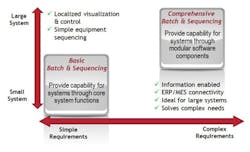Considerations for Selecting a Controller- or Server-Based Batch Sequencer
John Parraga, Global Product Manager, Rockwell Automation
To identify the right solution, let's consider the three types of batch and sequencing solutions: hard-coded, controller-based and server-based (often referred to as comprehensive). Very few systems leverage custom hard-coded configuration, as it only allows for setpoint downloads to a fixed sequence. As a result, when the sequence must change, users are forced to change the code. This adds risk to the process and can add significant cost to retest and validate the system. Because of the rigidity of a hard-coded solution, many engineers turn to a controller-based solution for their small batch needs. This is appropriate if the application requires sequence management capabilities, but the complexity of the process may not be great enough to warrant a server-based software package.
But how does one know if the complexity of the process calls for a server-based batch software package? A small system usually has a small amount of equipment, but can be accompanied by simple or complex requirements (see Figure 1 below). To determine whether or not a small system has simple or complex requirements, and therefore would benefit from a server-based solution, one must answer the following six questions. If every answer is yes, controller-based batch and sequencing may be sufficient.
- Does your system have less than 32 recipes?
- Is the complete batch built in a single (S88) unit?
- Can you define your batch procedure without branches or loop backs?
- Does your system capture less than four report values (real type) per phase instance?
- Does your system have four or less recipe parameters (real type) per phase instance?
- Does your system have enough controller memory for the application?
If only some, or none, of the answers are yes, a server-based solution is the more suitable choice. After considering the requirements of the system, engineers should also consider the pros and cons of each solution, starting with total cost of ownership. The real cost of a system must figure into the decision, whether the solution is long term or short term. A short-term solution may only consider the need to sequence phases in a controller, and not the need to capture activity data, while a long-term solution may consider activity traceability, as well as interactions with other systems.
A controller-based solution
Pros: Requires no additional upfront licensing investment (beyond HMI) and solves common controller-based sequencing needs. In addition, a controller-based solution is also beneficial in that it allows for flexible recipe management and enables local, single-unit supervision and control.
Cons: Requires more upkeep in terms of maintaining consistent recipes among similar units. A controller-based solution may cost nothing upfront, but if the system requirements change for example, requiring in-depth reporting, you will need to develop and test reports that are not part of the controller-based solution.
A server-based solution
Pros: Enables maximum flexibility for the most demanding batch requirements. Server-based solutions solve higher-level requirements, such as: class-based recipes, audit/diagnostics, extensive data collection and reporting, analysis and optimization, equipment arbitration, integration with MES/ERP systems, manual work instructions, recipe safe-keeping from the controller code and active material management, all while supporting multiunit coordination across multiple controllers.
Cons: More expensive upfront.
Pharmaceutical Manufacturer Implements New Batch and Sequence Management
AMPAC Fine Chemicals (AFC), one of North America's largest custom, small-molecule API manufacturers, weighed its batch configuration options and migrated its hard-coded control system to a controller-based solution. "AFC really needed a flexible control solution that offered easier system updates to accommodate their highly-varied manufacturing schedule," said Neal Yates, senior project engineer at Banks Integration, AFC's long-time automation partner.
"The project was originally scoped only for the control-equipment upgrade so there was no funding available for the addition of batch capabilities," Yates explained. "When I heard about the PlantPAx™ Logix Batch & Sequence Manager (controller-based solution), I immediately thought it would be an ideal alternative to a traditional server-based batch solution. I knew we could integrate it without increasing the overall cost of the project."
The Rockwell Automation PlantPAx Logix Batch & Sequence Manager is a controller-based batch and sequencing solution that is independent of application servers and software. As a result, Yates and the Banks Integration Group team were able to deliver a flexible, controller-based solution without the need for costly, engineering-intensive custom code or additional server infrastructure associated with large-scale batch solutions. In addition, the AFC team can now configure recipes and formulas directly in the controller through Allen-Bradley® FactoryTalk® View Site Edition software without requiring code changes to the system to help streamline the implementation of approved changes.
With the new system, plant operators at AFC have reduced their use of manual, paper-based batch sheets for detailed processing instructions, thanks to an automated solution embedded directly into the control system. "Many of our production processes require a high level of detail – for example, if we remove a kill solution that deactivates a volatile chemical too soon, it could significantly impact the entire process," said Mike Ryan, director of Automation Systems and Calibration at AFC. "With the automated batch solution we're improving the quality and consistency of our APIs, and avoiding the delays that naturally occur during manual operations."
Leading personal-wash company benefits from improved asset and production performance while meeting stringent quality standards. Although a controller-based solution was an option for a batch-configuration solution for AFC, PZ Cussons had a successful experience implementing a server-based solution into its high-speed liquid manufacturing facility.
As part of a complete overhaul and modernization of its U.K. supply chain, PZ Cussons decided to take advantage of the control and visibility capabilities offered by a modern process-capable automation infrastructure. While establishing the justification for a new U.K. manufacturing facility, the company realized that much of its existing process equipment at its old site was not meeting demands of a modern manufacturing environment.
Starting from a clean slate, PZ Cussons recognized many areas where savings could be made and unnecessary costs removed. It also wanted to adopt leaner manufacturing procedures making further savings in stock holding and deliveries. The primary challenge was to obtain visibility of all steps in the process and keep all parameters within operational tolerances. This required extremely accurate batching, mixing and metering systems, which could not only communicate with each other, but also with the master control system within the offices and external suppliers via a secure extranet.
An entirely new processing and production operation was developed, controlled by equipment engineered, supplied and improved by services from Rockwell Automation, along with instruments and fieldbus networks engineered, designed and commissioned by Endress+Hauser. The implementation of the project made full use of the diagnostic data that the fieldbus devices provide. This has given PZ Cussons a level of process visibility and control far beyond what its older plant had. The new approach is helping the company attain many of the savings it envisaged, while also removing many of the process variables which introduced unwanted costs.
PZ Cussons has effectively been able to deskill some processes that took operators many years to learn. Even then, each operator had their own way of doing things on each of the machines which led to some of the process variability.
With the old approach, all the recipes were hard-coded into the programmable logic controllers so there was no easy way to test new recipes and mixes without a significant recoding exercise. The new technology has allowed the company to pilot test new recipes on a small scale prior to mass production. Previously there was a need for specialist operators, but due to the scalability and portability of the software, any operator can now run any line. Operators are now much more multiskilled – adding value to the areas where their intervention really counts.
Conclusion
The selection method for a system shouldn't only be based on the size of the application. The level of complexity, flexibility and system requirements should all weigh into the decision. Selecting the right method when designing your batch and sequencing system will save you valuable design, validation and maintenance time.
About the Author
John Parraga
John Parraga

Leaders relevant to this article:

